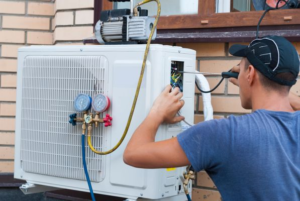Pests can damage property, harm health, and contaminate food. A good Pest Control company can lower these risks through thorough inspections and tailored treatments.
Biological pest control uses natural enemies to manage pest populations. This can be as simple as releasing ladybugs to eat aphids or as complex as introducing microbe-based solutions to the soil. Contact Abbotsford Pest Control now!

Taking preventive steps to keep pests out of buildings is key to safe and effective pest control. It involves a combination of steps, both inside and outside the building, to make it less attractive to rodents, insects and other pests. The most important step is to remove their sources of food, water and shelter. Cleanliness is also an important prevention measure. Clutter provides places for pests to breed and hide, so getting rid of it is essential. In addition, it is important to keep garbage tightly closed and dispose of it regularly. Food scraps should be placed in sealed containers, and kitchen counters should be cleaned on a regular basis to avoid buildup of crumbs. Water leaks should be fixed, and standing water eliminated, as this can attract many pests. Screens should be used on all windows, and exterior doors should be kept shut. In addition, periodic interior and exterior inspections should be made to look for cracks and holes that could allow pests to enter.
Sometimes, no matter how careful a building owner or maintenance worker is, it is impossible to eliminate all the potential sources of pests. This is where the other preventive measures come in, including keeping the outside of a building free of clutter and trimming back vegetation that comes into contact with the house.
It is also important to regularly clean and service septic systems, garbage disposals, drain traps and other drains and sewerage facilities to keep them working properly. Finally, it is important to educate employees and encourage a positive pest-control attitude. This includes providing them with accurate information about the kinds of pests that might invade their buildings, their preferred habitats, and what can be done to help prevent them from entering.
Pests can be very damaging and can cause disease, contaminate food, disturb indoor air quality and disrupt work production. They are often found in homes, but they can also infest factories and other workplaces. They can be spread by employees on their clothing, hair and skin, and on the things they bring into the facility.
Suppression
Once pest populations reach damaging levels, suppression of the pests becomes a priority. This often includes using cultural, physical, and biological control tactics to reduce the number of pests. Control measures must be chosen carefully to minimize harm to people and the environment. The best approach is to prevent pests from getting out of hand in the first place by monitoring and applying prevention methods.
Natural enemies of pests, such as predatory insects, parasitoids and pathogens, control pests by feeding on or killing them. The effectiveness of these enemies depends on the balance between numbers of the enemy and the population size of the pest it is attacking. For example, a tachinid fly that attacks caterpillars is effective only in the presence of caterpillars, and a parasitoid that kills scale insects requires the presence of scales on the host plant.
Weather conditions affect pests directly by killing or suppressing them, and indirectly by influencing their growth, development, activity and dispersal. Some weather events, such as hail and frost, increase pest damage, while others, such as rain or drought, decrease it.
Environmental features, such as mountains or large bodies of water, restrict the movement of some pests and thus can limit their impact. The availability of food, shelter, and water also influences pests. Some pests thrive only as long as the available food or roosting sites last, and they die or become inactive when these resources are exhausted.
Threshold levels for when action against a pest becomes necessary have been determined for many organisms. These thresholds may be based on esthetic or health considerations or on economic losses. For example, a few wasps flying around in a garden do not require action, but an infestation that threatens human health or the safety of structures or crops does.
Physical and mechanical controls reduce the amount of pesticide needed to achieve desired results by trapping, suffocating, burying, or blocking the pests or making it more difficult for them to survive or reproduce. Examples include putting out a trap crop such as zinnia to catch Japanese beetles, weeding with hoes or mulching the soil with materials that deprive the pests of sunlight and moisture. Biological controls employ microorganisms that kill or suppress pests, such as the pathogen nematode Steinernema carpocapsae, which reduces the occurrence of whiteflies, and Bacillus thuringiensis subsp. kurstaki, which kills thrips and other leaf-feeding mites. Biological controls usually attack only one species of pest at a time, or a closely related group.
Eradication
A pest control program can be designed to eradicate a pest population completely, or it may target specific species of pest at certain stages of their life cycle. Eradication is a difficult goal to achieve, especially for outdoor situations. Successful eradication programs are usually large-scale, involving multiple government agencies, private companies and individuals, and require funding at the local, regional and global level. They may also have to overcome a variety of obstacles, including resistance to the tools of eradication (insecticides and drugs in malaria or vaccine strain reversion in polio) or political problems and civil unrest (e.g., for a disease such as yellow fever).
A variety of physical traps, netting, and screens can be used to prevent pests from entering buildings or yards. These methods can be more labor intensive than chemical pest control, but they are generally safer for the environment and human beings.
Physical traps and netting are often less expensive than chemical solutions, but they may require maintenance to keep them effective. They may also have some limitations, such as the need to trap or kill pests to collect and remove them from an area, which is often viewed as inhumane, particularly when dealing with rodents and other larger animals.
Nematodes are microscopic worms that can be sprayed on crops or in gardens to kill fleas, grubs and aphids. They work by injecting their prey with toxic bacteria, causing them to break down and die. They are relatively safe for humans and the environment, although they can be harmful to certain plants, so they are best used in combination with other pest management techniques.
Other biological pest control options include predatory birds, bats and wasps, nematodes and earthworms. Some of these species are parasitic and attack only certain pests, while others feed on the waste products of pests, or even provide beneficial nutrients to the plants they live in.
Other types of pest control involve cleaning up and blocking access to food sources, such as clearing away rotting fruits and vegetables from outdoor areas, keeping woodpiles and other potential nesting sites away from buildings, and using mousetraps, jar traps, pheromone baits and other nontoxic traps. IPM advocates turning to old-school methods before resorting to chemicals, especially for pests that don’t pose a serious health threat, like silverfish and earwigs.
Monitoring
Monitoring is the first step in the IPM process and it’s critical for identifying pest infestations at their lowest levels of activity. This allows pest control treatments to be applied in a manner that is least disruptive and most environmentally compatible. It also provides valuable information for determining the effectiveness of control tactics and predicting when pest populations may reach damaging levels that require action.
Monitoring involves random inspections of internal and external vulnerable areas, monitoring for changes in the severity of infestation and observing the effects of biological controls (natural enemies) and other management activities. In addition, sampling of plant material and the use of sticky traps can be used to monitor pest population levels.
The most important part of monitoring is defining the pest action threshold – the point at which pest populations or environmental conditions indicate that pest control must be initiated. The most effective way to determine the action threshold for a food processing environment is through regular inspections by professional pest management companies and by company staff. A Pest Sightings Register should be maintained at all sites which details the date, pest, location and the subsequent actions taken.
An essential tool for inspection is a flashlight, as pests often live or seek shelter in dark harborage areas such as corners and crevices of equipment, walls and storage containers. An extendable mirror can also aid in inspection behind and beneath equipment and furniture, as well as locating maintenance needs or sanitation deficiencies. A magnifier helps to identify insect parts and frass (excrement) which can be indicative of infestation.
A pest log is also useful for tracking and analyzing pest sightings, helping to identify hotspots and determine the frequency of pest sightings. This information can be used to prioritize pest management efforts and guide the placement of traps or monitoring devices.
Physically controlling a pest is a relatively straightforward activity, and can include traps, screens, barriers, fences, nets, radiation, heat, electricity or chemical alteration of the environment to deter or destroy a particular pest. Physical controls can also be a form of preventive or remedial maintenance and include caulking, sealing, repairing screens and doors, putting in new doors, and replacing damaged ones.








